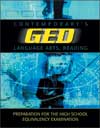 |  Contemporary's GED Language Arts, Reading John M. Reier
Synthesis
Web LinksThe following links contain information concerning the synthesis of ideas when reading literature or prose.
When you have finished all the activities in Chapter 4, go on to Chapter 5.
Synthesis
(http://tep.uoregon.edu/resources/assessment/multiplechoicequestions/blooms.html#synthesis)
This site provides a definition of the synthesis level of Bloom's Taxonomy. |
 |  |  | Critical Thinking and Reading Strategies
(http://www.uwlax.edu/faculty/braziel/lecture1.html)
This site provides an explanation for various patterns of organization or methods of development that a writer uses to integrate or synthesize information. |
 |  |  | Tone: The Attitude of an Author
(http://www.gpc.peachnet.edu/~issowl/handouts/authors-tone.pdf)
This site defines tone in the context of literary analysis. Several examples of tone are provided in sample paragraphs. |
 |  |  | A Clean Well-Lighted Place
(http://www.online-library.org/fictions/cleanplc.html)
This site provides the full text of "A Clean Well-Lighted Place," one of Earnest Hemingway's famous short stories. |
 |  |  | Tone and Style
(http://www.gc.edu/DistanceEd/English/dtaylor/1302/stories/tonestyle.html)
This site provides exercises to go with the short story "A Clean Well-Lighted Place" (above). Read the story and then follow the directions for analyzing the tone and mood of this selection. |
|



 2002 McGraw-Hill Higher Education
2002 McGraw-Hill Higher Education